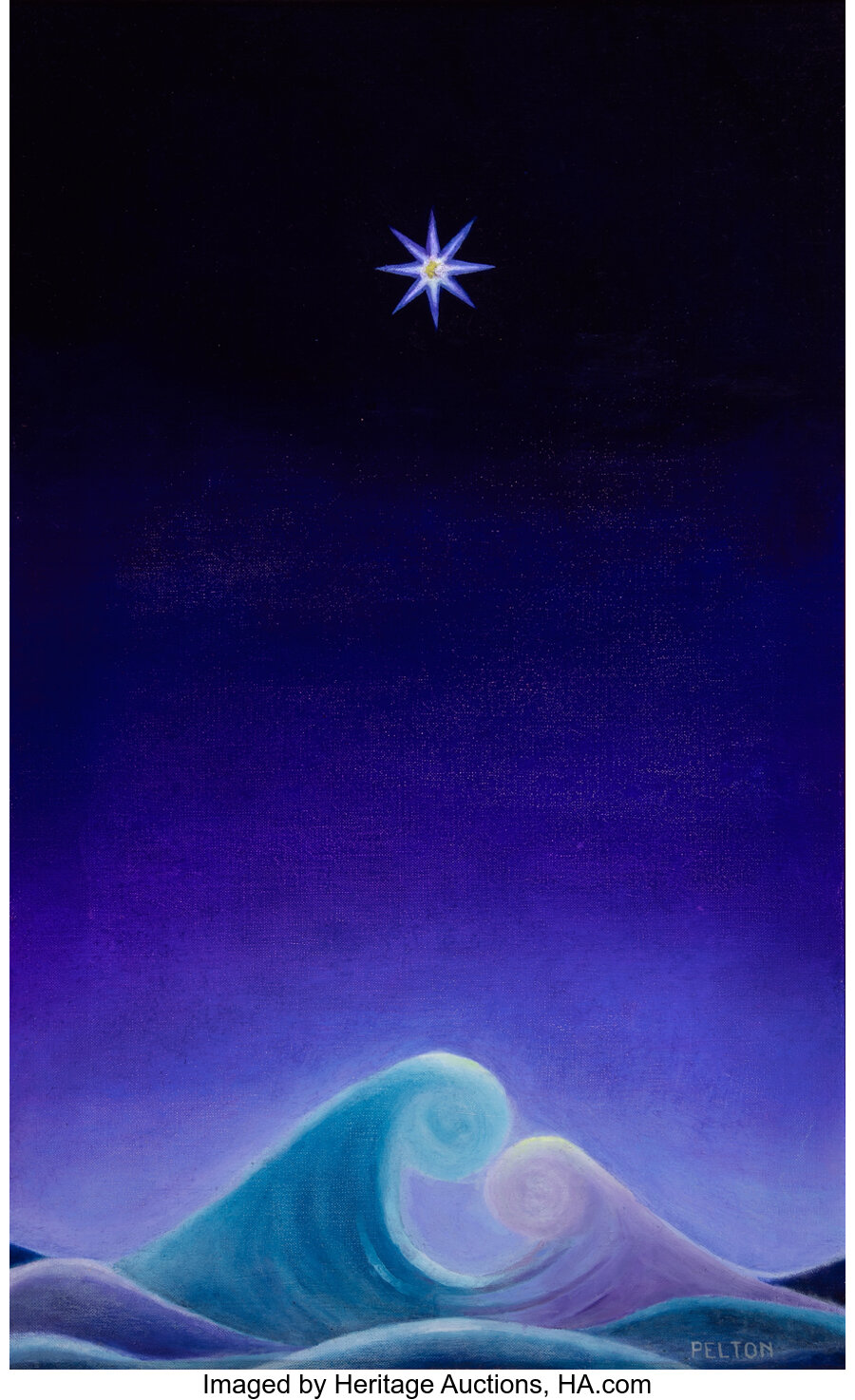Signed lower right: Pelton
The artist; Private collection, acquired from the above, circa 1941; Private collection, East Sussex, England, acquired from the above, 2008.
Agnes Pelton (American, 1881-1961) Purple Star Icon, conceived 1936, completed circa 1939-1940 Oil on canvas 23-1/2 x 14-1/2 inches (59.7 x 36.8 cm) Signed lower right: Pelton Signed and titled on the reverse: Purple Star Icon, Agnes Pelton PROVENANCE: The artist; Private collection, acquired from the above, circa 1941; Private collection, East Sussex, England, acquired from the above, 2008. LITERATURE: The artist's sketchbook/notebook, entry of conception sketch, 1936; M. Stainer, inventory of Agnes Pelton's Symbolic Abstractions from years 1923/24-1961, 1989 (recorded in entries for year 1940: Challenge, Nurture, Purple Star Icon); M. Stainer, Ohlone College Art Gallery, Fremont, California, Agnes Pelton, October 9-November 5, 1989, exhibition catalog, p. 22; Richard York Gallery Records, Archives of American Art, Smithsonian Institution, Washington, D.C., listed in Artist's Files 1922-2008, Agnes Pelton, Box 86, Folder 23 (12 x 8 in. version of Purple Star Icon). "Agnes Pelton was a visionary symbolist who depicted the spiritual reality she experienced in moments of meditative stillness. Art for her was a discipline through which she gave form to her vision of a higher consciousness within the universe. Using an abstract vocabulary of curvilinear, biomorphic forms and delicate, shimmering veils of light, she portrayed her awareness of a world that lay behind physical appearances—a world of benevolent, disembodied energies animating and protecting life. For most of her career, Pelton chose to live away from the distractions of a major art center, first in Water Mill, Long Island, from 1921 to 1932, and subsequently in Cathedral City, a small community near Palm Springs, California. Her isolation from the mainstream art world meant that her paintings were relatively unknown during her lifetime and in the decades thereafter." - B. Haskell, Whitney Museum of American Art, Agnes Pelton: Desert Transcendentalist (www.whitney.org) Agnes Pelton's Purple Star Icon emerges as an exceptional piece among her rare transcendental abstractions. Remarkably, only four of such transcendent works have graced the auction block in the twenty-nine years between 1995 and the present. This larger variant of Purple Star Icon, transcending the boundaries of the original with its more diminutive dimensions, was known only through archival records until now. This larger version of Purple Star Icon carries the same title as its smaller counterpart, a work previously recorded in Robert Knott's survey "Abstract Art of the 1930s and 1940s," published by Wake Forest University's Fine Arts Gallery in 1988. The grand unveiling of this present masterwork draws back the curtain on a treasure previously known only in theory. The original sketch and handwritten notes documenting the nascent idea for Purple Star Icon appear in Pelton's notebook/ sketchbook covering the years 1936-1949 (Agnes Pelton papers, 1885-1989, Archives of American Art, Smithsonian Institution). Pelton's entry indicates that the composition was conceived in June or early July of 1936, four years into the artist's residence in Cathedral City, California, near Palm Springs, where she lived and painted from 1932 until her passing in 1961. Under the vast desert sky, she penned the inception of this work: "Purple Star Icon Intense deep purple around star- duller blue but not much lighter away from it, & not too light toward horizon - Deep night - Star luminous white points not too sharp. Double wave [pencil drawing] Darker & lighter again. Sky showing spots of reflection of star in trough of wave." Immersing herself in the magical desert setting of Cathedral City proved pivotal in Pelton's transition to transcendental abstraction. Scholar Rachel Middleman writes: "Pelton moved to the California desert to find an environment of nature and solitude in which her visions, spurred through meditation, might materialize as art works. Pelton appears as an outlier of mainstream modernism not only in terms of her physical location but also because she was a female artist who openly commingled unconventional, personal spiritual beliefs with an artistic practice that never fully rejected figuration. Pelton used the materiality of paint to represent spiritual intuition in a non-illusionistic manner. While appearing rich with symbolism, her abstractions are not easily decoded or read, as her compositions arose from such personal sources as her dreams, waking visions, and perceptions of nature. Her paintings are meant as profound encounters and, like Theosophical teaching, are open for the viewer to interpret through his or her own experience." (Enchanted Modernities chapter "Outlying Modernism: Agnes Pelton, Theosophy, and Gender," Agnes Pelton Tells About Modern Art in the Abstract, Desert Sun, Palm Springs, California, February 16, 1934, as quoted in Stainer, Agnes Pelton, 1989, p. 32) Middleman elaborates on the subject, citing a direct quote from Pelton herself, stated during this watershed period in the artist's life: "My abstract pictures are just as real to me as nature, but they are not material, but mental images. They are a culmination of impressions which come to me at a quiet time just exactly as a line of verse comes to a poet's mind; the only difference being that I see it in form and color, and the poet sees it in sound and words. All of my abstractions have to do with light and beneficence of light, for light is really all life, you know." (ibid. 32) In the pantheon of Pelton's abstract creations, the color blue holds a place of singular prominence—acting as a conduit for her profound metaphysical explorations. Purple Star Icon exemplifies this predilection with a symphony of blues ranging from the deepest midnight to the softest periwinkle. These hues imbue the canvas with a tranquil yet potent vitality, echoing the vastness and mystery of the cosmos. Pelton's adept manipulation of tonal gradients coalesces into a palpable sense of depth, lending the work an almost sculptural quality despite its two-dimensional plane. Further enhancing the visual narrative is the canvas's otherworldly luminosity, a signature element of Pelton's technical virtuosity. Here, the central luminescent star seems not merely painted but alight from within, a celestial body that has captured a shard of the infinite. This masterful conveyance of inner light is not simply a representation but a revelation, allowing viewers to perceive a glow that transcends the physical pigments and resonates with the spiritual intensity that defines Pelton's oeuvre. Through her pioneering techniques, she achieves a transcendental luminance, a quintessential feature that underscores her status as a luminary in the realm of American abstract art. The Pelton works with a blue palette most comparable to that of Purple Star Icon are Star Gazer, The Guide, and Ahmi in Egypt. It is worth noting that the compositions of Star Gazer and The Guide echo the symmetry evident in Purple Star Icon. Pelton not only considered her palette but also how she signed her works from this period. Her signature, "PELTON," etched in the lower right in assertive capital letters, is not merely a mark of creation but a statement. During her alignment with the Transcendental Painting Group from 1938 to 1945, Pelton chose to gender-neutralize her inscription, a bold choice that reflects the spiritual universality she sought within her works. In the realm of her transcendental abstractions, Purple Star Icon is one of a small number of luminous works that delves into the realm of water-related symbolism. This theme resonates through her oeuvre, with The Fountains being another notable example that fetched a record-breaking $3.438M at auction in May 2023. Pelton's affinity for the cosmos is no fleeting fancy; it is a profound connection that began to weave its way through her abstract works after her inaugural visit to California in 1928-29. Stars became recurring symbols in her art, reflecting her belief in the cosmic communion between the celestial and the spiritual. Erika Doss, in her book Spiritual Moderns: Twentieth-Century American Artists and Religion, captures Pelton's celestial muse with excerpts from the artist's own correspondence and journal entries, revealing a profound spiritual engagement with the stars—not as distant, cold lights but as entities rich with "marvelous and indefinable emanations:" "In a letter to Transcendental Painting Group co-founder Raymond Jonson, [Pelton] enthused: ‘Do you watch the stars these summer nights? Marvelous and indefinable emanations descend from them-something new-neither sound, sight, or smell. I only know that something wonderful goes on and that a faculty will sometime develop to apprehend it, if we preserve an open sensitiveness to it." (E. Doss, Spiritual Moderns: Twentieth-Century American Artists and Religion, Chicago, Illinois, 2023) In a 1932 journal entry, Pelton elaborates: "A night under stars. Coming out of sleep & consciousness overlapped a moment, and I held a nearer feeling or perception of the stars. I was nearer them, or else their potencies reached me—rayed out toward me, softer, filial, or streaming, speaking, reaching, giving messages..." Pelton's affective response to the stars indicates how she comprehended spirituality through felt experience. The discovery of Purple Star Icon places it alongside other Pelton star-anchored compositions with which it shares a symbolic kinship: Star Gazer (1929), The Guide (1929), Lotus For Lida (1930), Illumination (1930), Even Song (1930), Ahmi In Egypt (1931), Sand Storm (1932), Day (1935), Resurgence (1938), Future (1941), and Purple Star Icon are all celestial canvases inspired by the "woman who saw wonders in the sky," inviting the viewer into an astral narrative where spirituality and art converge. In a contemporary context, the discovery and subsequent public offering of Purple Star Icon reveal Pelton's legacy as an incomparably visionary painter who transcended the visual plane to touch the spiritual. It joins her pantheon of cosmic creations, standing as a radiant testament to her role as an artist who not only gazed upon the heavens but felt their sublime influence. On April 21, 2024, the former home and studio of Agnes Pelton in Cathedral City, California, where Purple Star Icon was conceived and painted, was officially designated a historic landmark. Through this work, Pelton continues to inspire us to seek the ethereal threads that connect our earthly experience with the infinite dance of the universe. "There is nothing quite like Pelton's paintings in 20th-century American art." – Roberta Smith, The New York Times We thank Mr. Michael Kelley for the information he has kindly provided about this work. HID12401132022 © 2024 Heritage Auctions | All Rights Reserved
Original, unlined canvas. The work appears to be in original condition. Under UV exam, there does not appear to be inpaint. Faint 1 inch scuff in the lower right corner. Retains original frame.
Framed Dimensions 27 X 17.5 Inches


